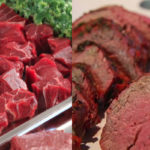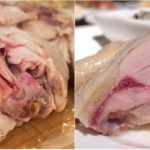Why do chicken bones turn red when boiled?
It’s a common occurrence for boiled chicken bones to turn red (this can also happen with other types of meat). Animal bodies contain two types of proteins: Hemoglobin (Hb) and Myoglobin (Mb). Hemoglobin is responsible for supplying oxygen to small blood cells, while Myoglobin has a stronger bond with oxygen and is usually stored in bones and muscle tissues.
Poultry like chickens and ducks have both white and slightly darker red meat (often found in legs and wings, areas with higher activity).
At first glance, Myoglobin looks similar to blood, but it is not. Blood will quickly clot when exposed to air. This has led many to wonder why chicken bones still turn red even after prolonged boiling at high temperatures.
The phenomenon of red bones (and sometimes red meat) is more common in younger chickens. This happens because the bone and muscle structure is not yet fully developed, and when the chicken is cut, the Myoglobin reacts with air and mixes with water, forming a liquid that flows out. This is also why a rare steak will have a dark red liquid oozing out when cut, but it doesn’t have the strong, pungent smell of blood.

It’s normal for boiled chicken to have red bones and meat.
Tips to prevent red meat and bones when boiling chicken:
– Altering the pH of the environment
Adding vinegar or lemon juice changes the pH, preventing the red discoloration in chicken bones and meat. You can use lemon (or vinegar) and salt to rub and marinate the chicken before cooking to eliminate any unpleasant odors and reduce the chances of red meat and bones.
Many European and American dishes often marinate meat with lemon juice to make the skin crisp and prevent Myoglobin from changing color when exposed to air.
– Separating the bones and meat
Another way to avoid red meat and bones when boiling chicken is to separate the meat from the bones. Boil the meat and use the bones to make a broth.
How to tell if chicken is cooked:
According to experienced chefs, the best way to check if meat is cooked is to use a thermometer to measure the temperature at the thickest part of the meat—for chicken, this would be the breast and thigh. A temperature above 80 degrees Celsius indicates that the meat is cooked and safe to eat.
A traditional method used by home cooks is to pierce the thigh with a small skewer or chopstick. If there’s no pink liquid coming out, the chicken is cooked.
How long to boil a chicken:
Everyone has their own method for boiling chicken. Some start with cold water, while others use hot water. If you want sweeter meat, it’s best to put the chicken in boiling water, as this retains the nutrients. However, this method can cause the skin to shrink and crack suddenly. To prevent this, you can place the chicken in cold water and gradually heat it up, allowing the chicken to cook from the inside out. Boiling chicken in cold water also helps prevent red bones. Remember to skim off the foam regularly. Adjust the boiling time depending on the size and type of chicken (young or old, free-range or industrial).
Once the water boils, turn down the heat to maintain a gentle simmer, cover, and cook for 5-10 minutes. Then, turn off the heat and let the chicken sit in the hot water for about 30 minutes. This ensures even cooking, prevents red bones, and results in juicier meat.
Boiling at a low temperature helps preserve protein and amino acids, making the meat juicier and sweeter.
When boiling chicken, add salt, ginger, and onion for flavor.
After the chicken is cooked, plunge it into a bowl of ice-cold water. This tightens the skin, making the meat firmer and easier to cut. Don’t cut the chicken while it’s still hot, as it will release juices and become mushy.
Is the Red Liquid Oozing Out of My Steak Blood?
Steak au poivre is a French culinary masterpiece, a dish that tantalizes the taste buds with its unique combination of seared beef, a hint of frying, and a symphony of spices including oil, fat, and the subtle sweetness of onions. However, a question that often arises when indulging in this delicacy is whether the red liquid that escapes from the meat is blood. Join us as we demystify this culinary conundrum and explore the true nature of this savory essence.






































